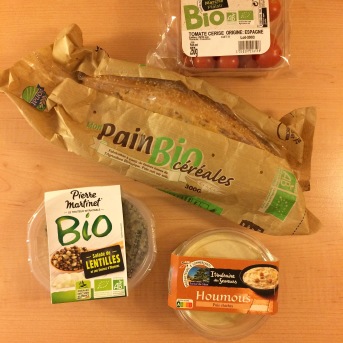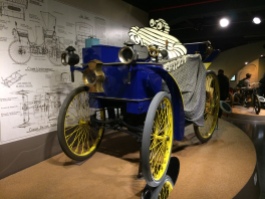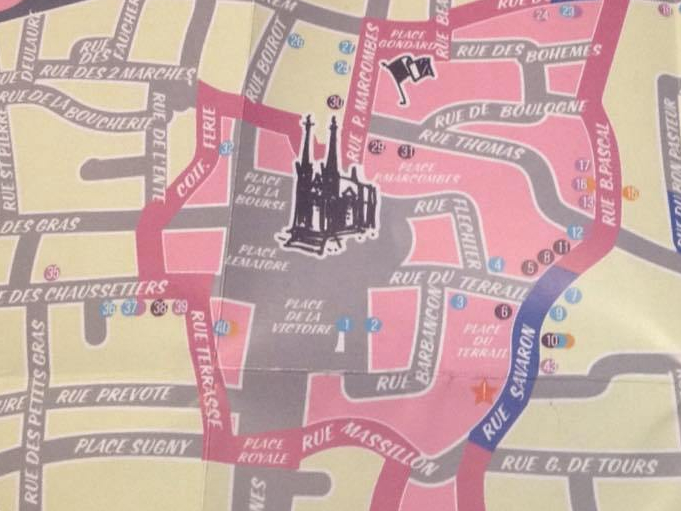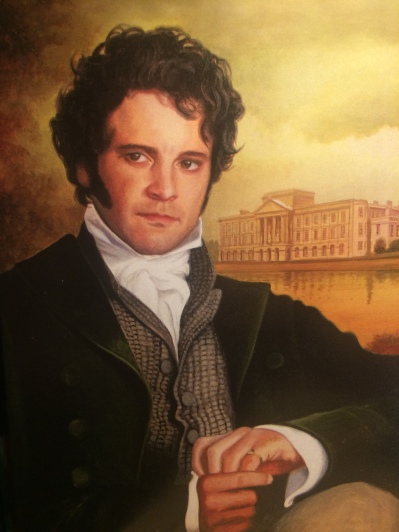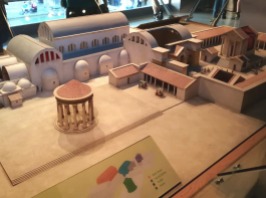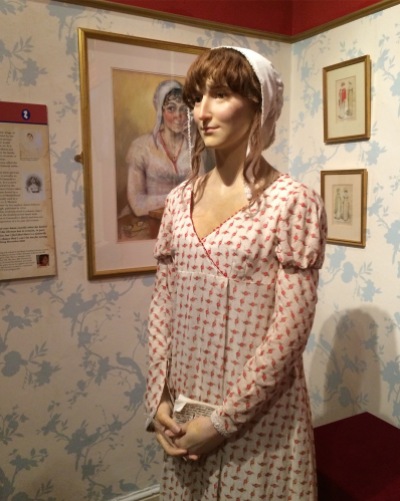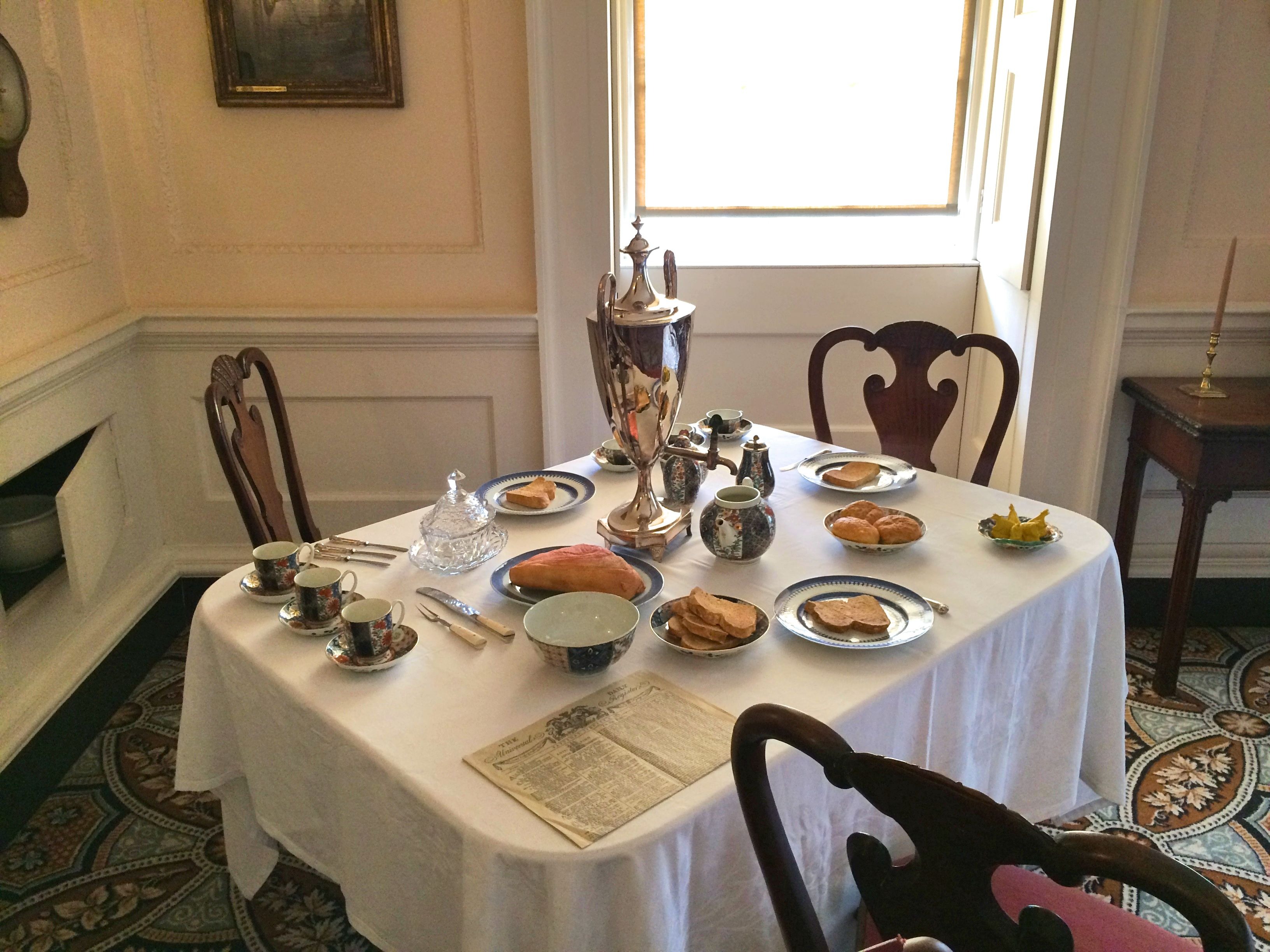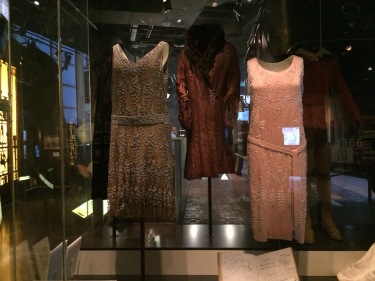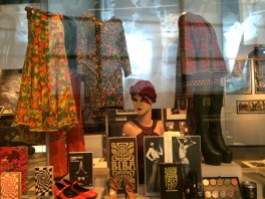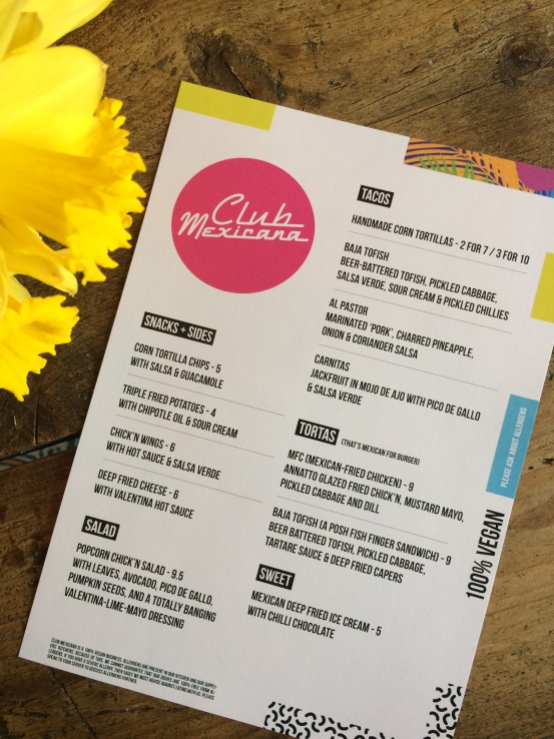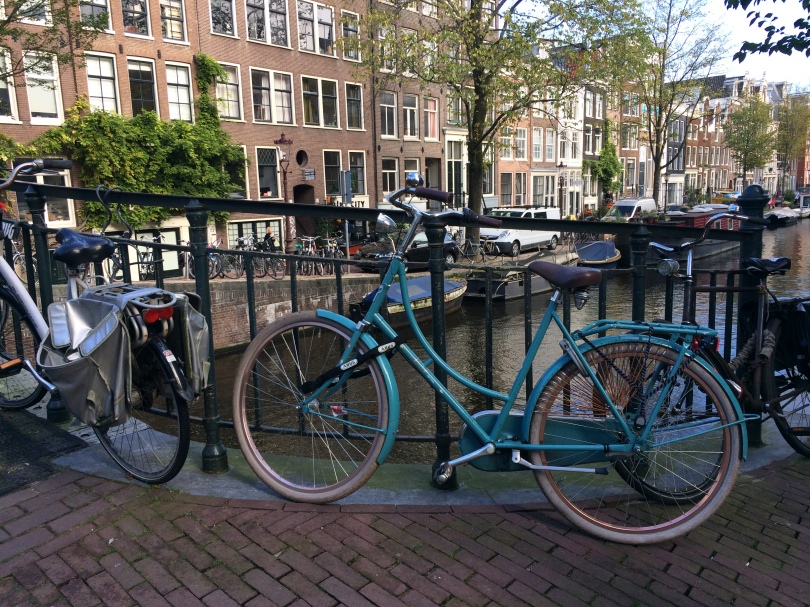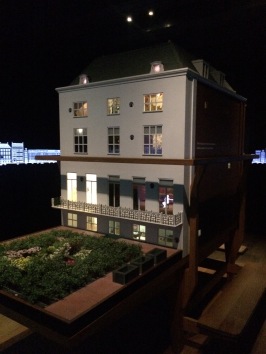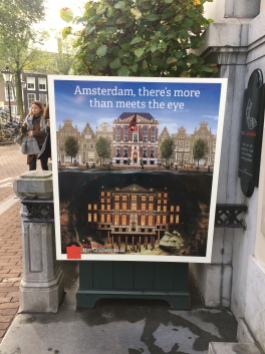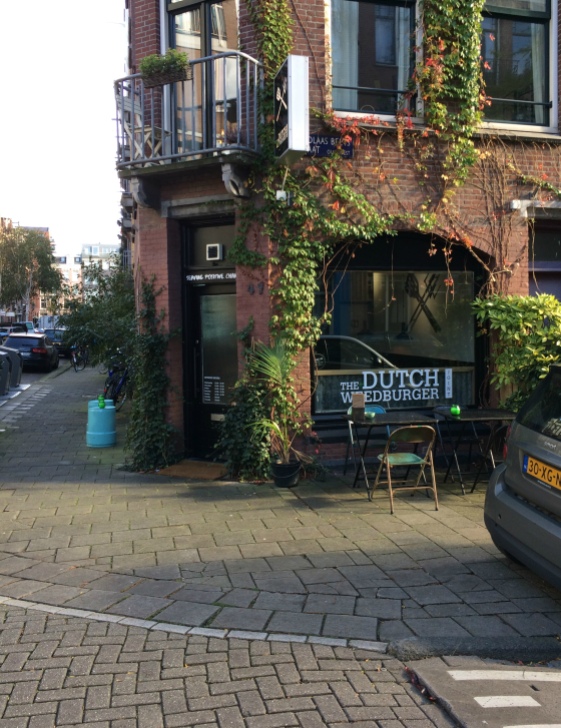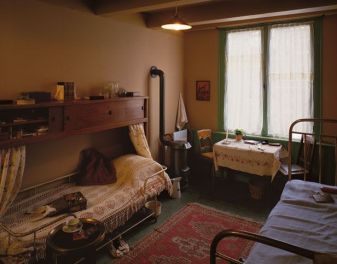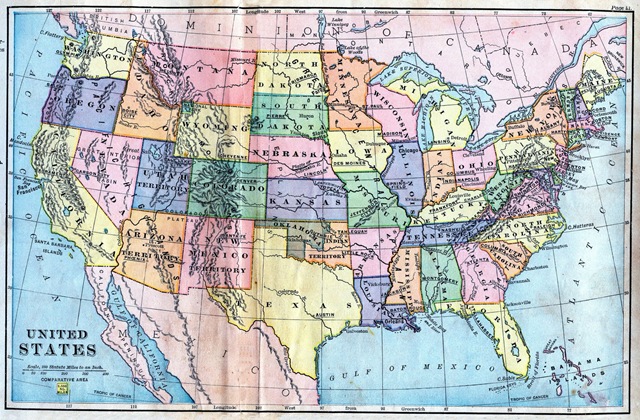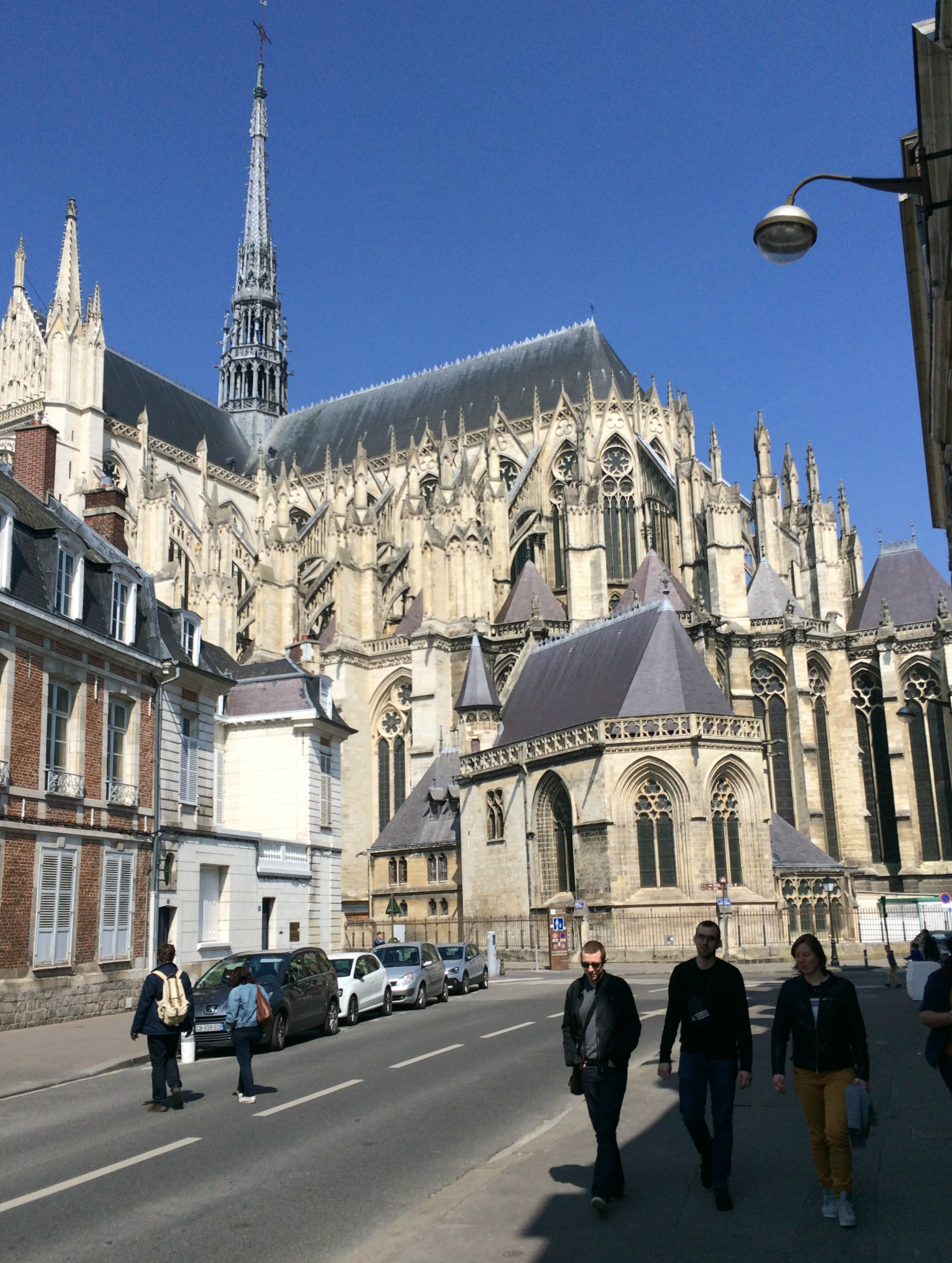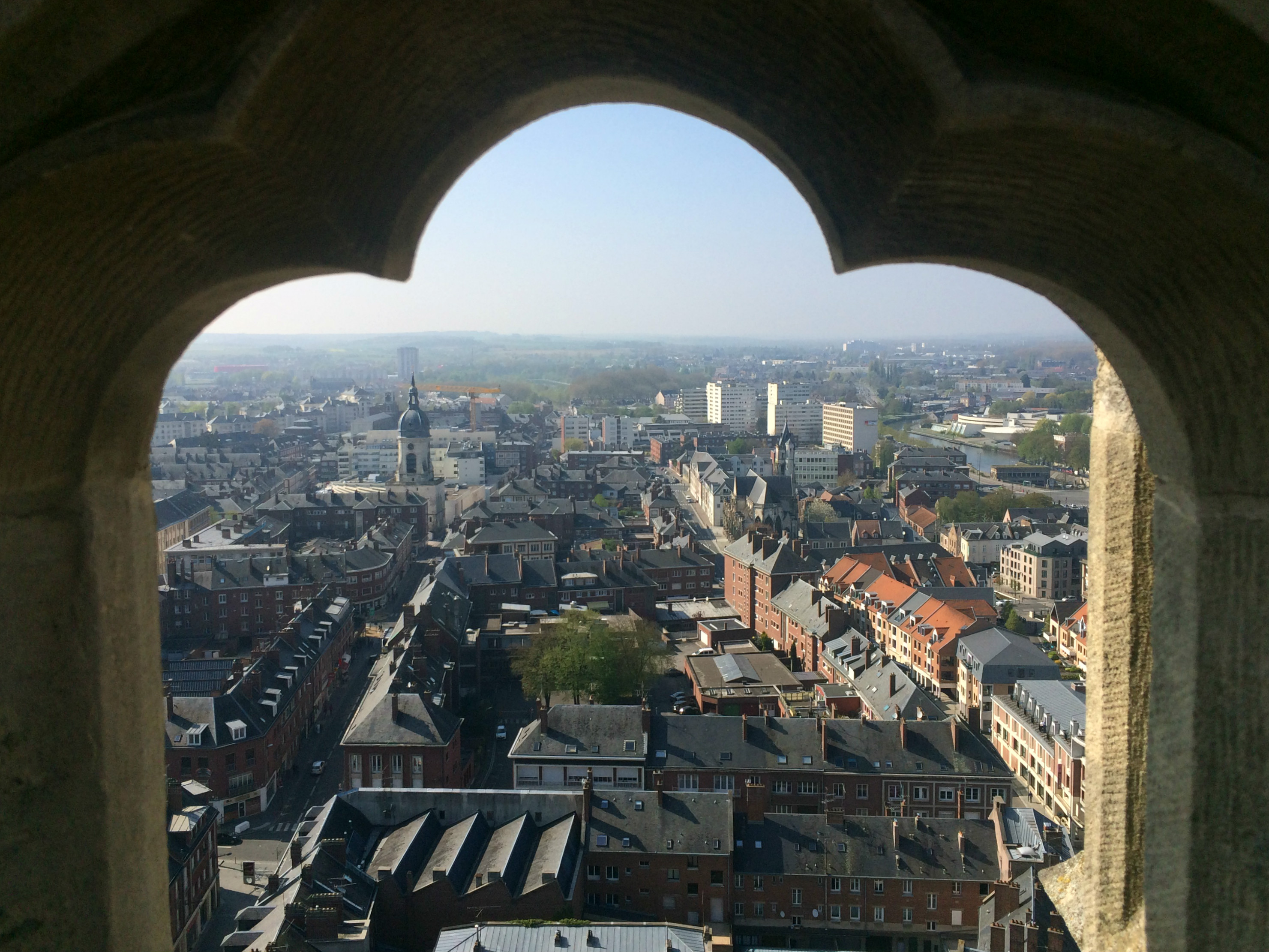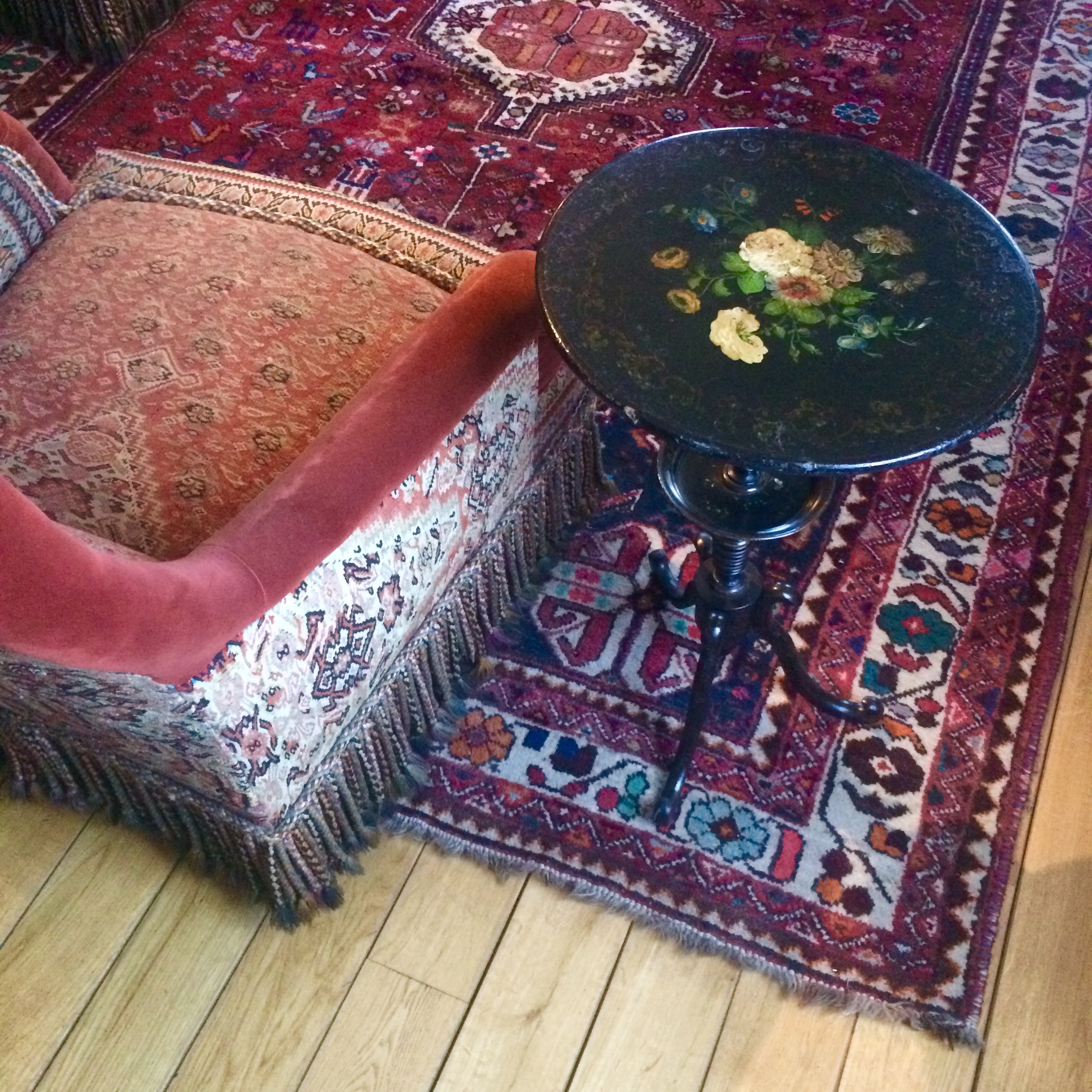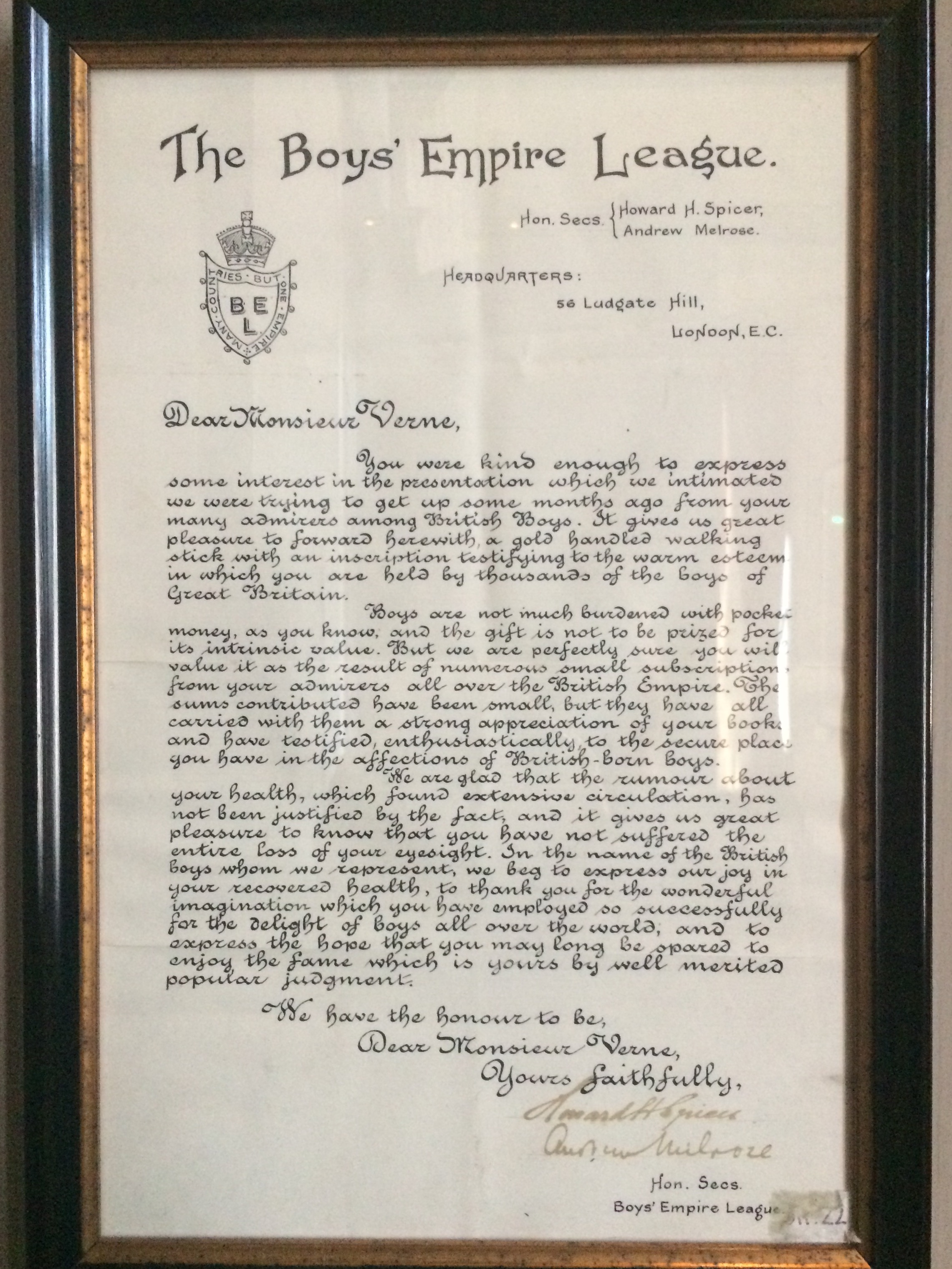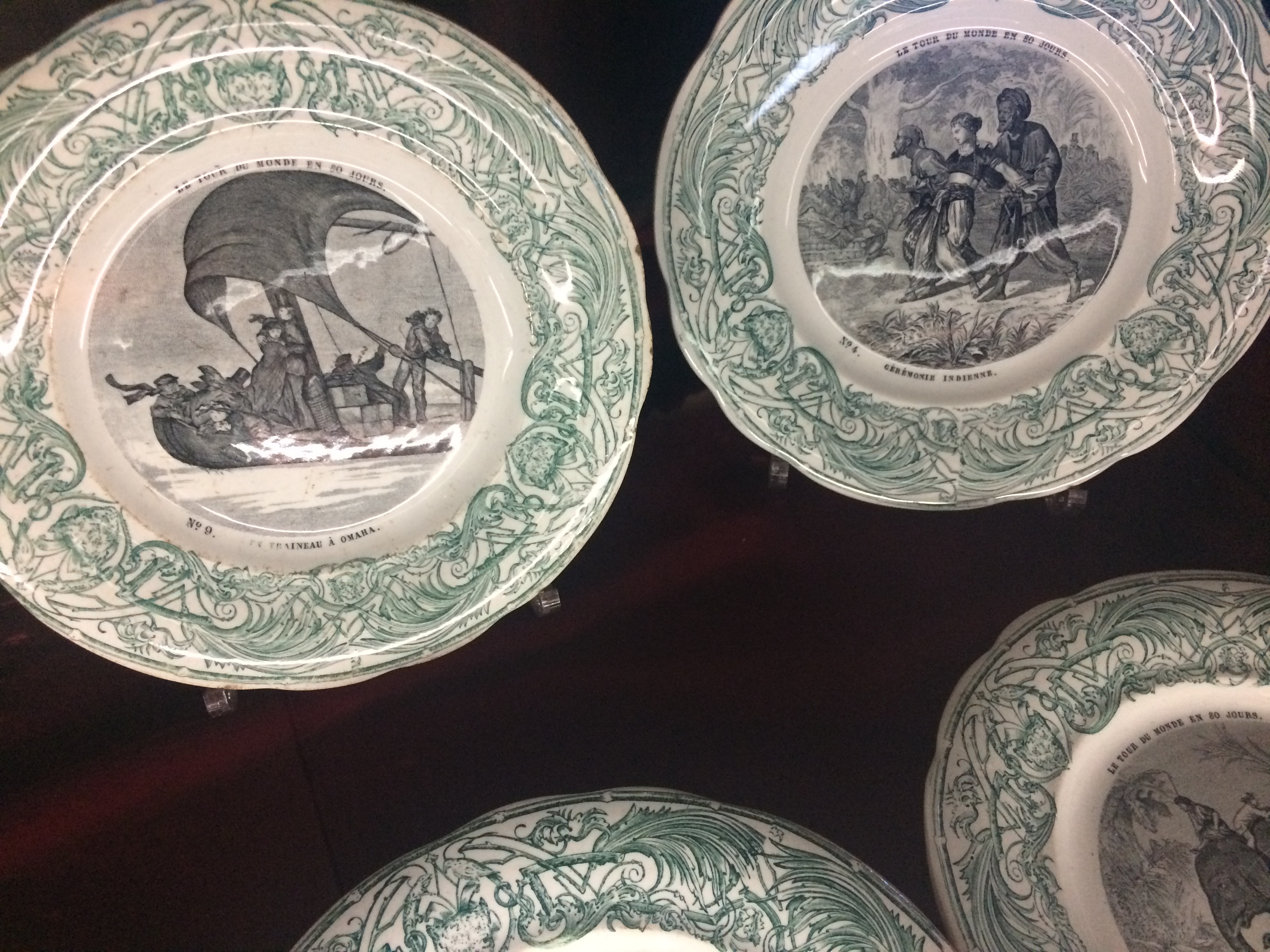How could I let so many years go by without ever visiting Amsterdam? This is the question I began asking myself almost as soon as I arrived. It’s so close to me (just an easy three-hour TGV from Paris) and has so much to offer.
I soon fell in love with this charming city teeming with bicycles and crisscrossed by canals. I adore the stately narrow houses standing guard alongside them, topped with ornate gables of various kinds. My favorite is the stepped gable but the other kinds—with a vaguely Haussmannian sloping slate roof or a piping of white frosting trim—are beautiful too.


In the second photo above, you can see a hook hanging down from the top of the building. These were installed on most houses for the purpose of moving furniture in through the windows rather than up the stairs (the stairs in many buildings are steep with shallow steps—I would have appreciated a hook option to get my suitcase up to my hotel room!). These houses were also built to lean slightly forward so the items being hoisted up and down wouldn’t scrape across the façade. For houses without a hook, people use the same kind of exterior elevator you can sometimes see in Paris.
This trip was also the chance to increase my number of countries visited and get a bit closer to beating my brother in our friendly “who’s traveled the most” competition. He is frustratingly one country ahead of me at the moment, although I still think he shouldn’t be allowed to count business trips! (sore loser, yes). 😉



Another thing I enjoyed in Amsterdam were the chances to try figuring out the exact meaning of signs and writing (and overheard talk) using the bits of Dutch that I know thanks to the Belgian delegation of my United Nations of friends.
Of course, their purpose is obvious right away… the first one means that if you’re not careful, a giant angry dog could burst out of nowhere and dispatch you to the hereafter, but how do they say it exactly? In English, we get right to the point with “Beware of dog” while in French it’s “Chien méchant” (mean/dangerous dog), which gives only an implicit warning. In Dutch the sign reads “Hier waak ik” or “I’m watching (over)/guarding here”—again requiring the would-be trespasser to draw conclusions. The different approaches to conveying a single message are interesting.
In the second photo, a sticker alerts mail carriers to the types of junk mail the occupant does or doesn’t accept. And in the third one, a friendly-looking sign with a rhyming poem tells people that they can park their bikes there if they’re going into the nearby café. As a translator, my natural impulse is to try coming up with an English equivalent that also rhymes… something like “Coming in for a beer? Then you can park here.” But then the idea of tea is lost, and the syllable count isn’t quite right. But this gives you an idea.


The first thing you notice upon arriving in Amsterdam is probably how very many bikes there are. In the city center they far outnumber cars, and as you explore the streets you see them chained to any and all conceivable fixtures, even (or especially?) when there’s a sign warning people not to). It seems an extremely practical way to get around, and very eco-friendly of course. For those times when biking isn’t possible, there are buses, trams and even a subway with a couple of lines. As a pedestrian, however, you have to be very careful when crossing streets as the chance of stepping in front of a silent but rapidly approaching bicyclist is always high. Especially at night, when bikes are not only silent but practically invisible. I suppose when you live there you have the reflex of looking carefully both ways even in the absence of engine noise.

The second thing that stands out is the number of canals. I’d already known there were canals there, but hadn’t realized how extensive they are. This city of 219 sq. km has over 100 km of canals (spanned by some 1,500 bridges, each with its own name)—far more than in Venice. In fact, Amsterdam is often referred to as the Venice of the north. The canal ring area, dug in the 17th century during the Dutch Golden Age, was listed as a UNESCO World Heritage Site in 2010.

As you can see in this 1671 map by Joannem de Ram, the city is a veritable spiderweb of waterways. A number of maps like this are on display at Het Grachtenhuis (the Canal House), a very cool little museum that I discovered by chance.
Its multi-media exhibits tell the story of Amsterdam in a unique and entertaining way, incorporating video, holograms, claymation, physical models and projected images that create a sort of augmented reality to take you back in time. You learn why the canals needed to be dug, how their layout was chosen, why the city’s houses sometimes lean to one side and what lies beneath them. One of the highlights is a model of the Grachtenhuis itself with its rooms furnished in the styles of different periods from its history. It seems that a popular hobby among rich Amsterdam ladies back in the day was to have a dollhouse version of their own home made. I wonder, was it strictly for show or did they also play with their mini-house when no one was around?
Amsterdam is also a place where you can see a few species of very, very small cars. I remember the first time I saw a Smart Car, on one of my early trips to France—they’re so small compared to typical American cars that we took photos of ourselves next to them, even in the days of film cameras when doing so was arguably wasteful. But those are luxury sedans next to these little guys (the official term for vehicles this size is microcars). The first red car and the white car above are Cantas, developed in the Netherlands specifically as a mobility aid for disabled drivers. They run on gasoline, and when I encountered one going down the road its engine sounded like a lawn mower. They’re allowed to drive on sidewalks and you don’t need a driver’s license to operate them. And as you can see, they need to be secured to something with a chain, since just about anyone could pick one up and tuck it under their arm. The black cars are examples of the Birò, the world’s smallest electric car. See it in action here. So cute! You also won’t want to miss the Canta ballet.
Our wanderings through the city were sometimes random and sometimes purposeful, as we had come in part to find some of the space invaders installed back in 1999 by the eponymous French street artist. Those of you who follow my Instagram already know that we succeeded! Out of the original 26, we found 18, although many if not most of those had been “reactivated” (replaced) by fans due to destruction of the originals. Some of them have a small row of tiles installed underneath them, and we were thinking this might be to indicate that they’re reactivations.
After a morning of Invader-hunting, it was time to refuel at Vegan Junk Food Bar. I won’t say much here as I mainly wanted to share these photos and pass on the name before moving on to Van Gogh. Suffice it to say that these burgers were pretty much life-changing, and that those are sweet potato fries with scallions and a truffle mayonnaise. Yes!
So, of all Amsterdam’s museums, the most “must-visit” of them all is undoubtedly the one devoted to Vincent Van Gogh. It’s the largest collection of his works, and he was very prolific for a time before unfortunately slipping into madness. Among other works, you can see these very famous pieces. And also take the artist home with you in crocheted form. In an interesting coincidence, the temporary exhibition of the moment was The Dutch in Paris.
Something funny happened one morning when we were in search of food and realized that the coffee shop across from the hotel offered a vegan breakfast. Okay, we already knew what “coffee” shops in Amsterdam were really about, but were sort of thinking that if they also served food, maybe it was more of a restaurant during the day. And perhaps this one was, but that didn’t stop people from also coming in to smoke. It was a bit surreal to be sipping at your coffee and eating baked beans on toast while at the same time inhaling fumes of a most herbaceous kind from the next table (and baked beans on toast are already strange enough for me). Furthermore, as smoking in buildings has been banned for some ten years already in most of Europe—including in the Netherlands, for regular cigarettes—it was odd to have ashtrays on the tables. Not that I’m even opposed to this kind of thing… it’s more that it hasn’t come into my reality for a long time. Anyway, we saw the humor in it though and weren’t deterred from enjoying our breakfast. Well, as far as possible, since it was a somewhat underwhelming breakfast, especially since they had no plant-based milk and a coffee with milk in it is one of the cornerstones of breakfast for me. But it was filling enough and did the job. Looking more closely at the menu after eating, we noticed the “Happy English” option—an English breakfast “with Popeye’s spinach :)” and wondered just how this “spinach :)” was incorporated (space breakfast?) or if the dish came with a rolled combustible as a dessert course.
That evening, my friend bought a vegan space cake (actually a space cupcake) from the same place to have at the hotel. I was almost going to have part of it but then decided not to, as I’d heard something about unpredictable results and wasn’t in the mood for unpredictable things. The effects of this cupcake, however, were reportedly just as underwhelming as the breakfast, but we both enjoyed the drawing of the enthusiastic chef, so there was that.

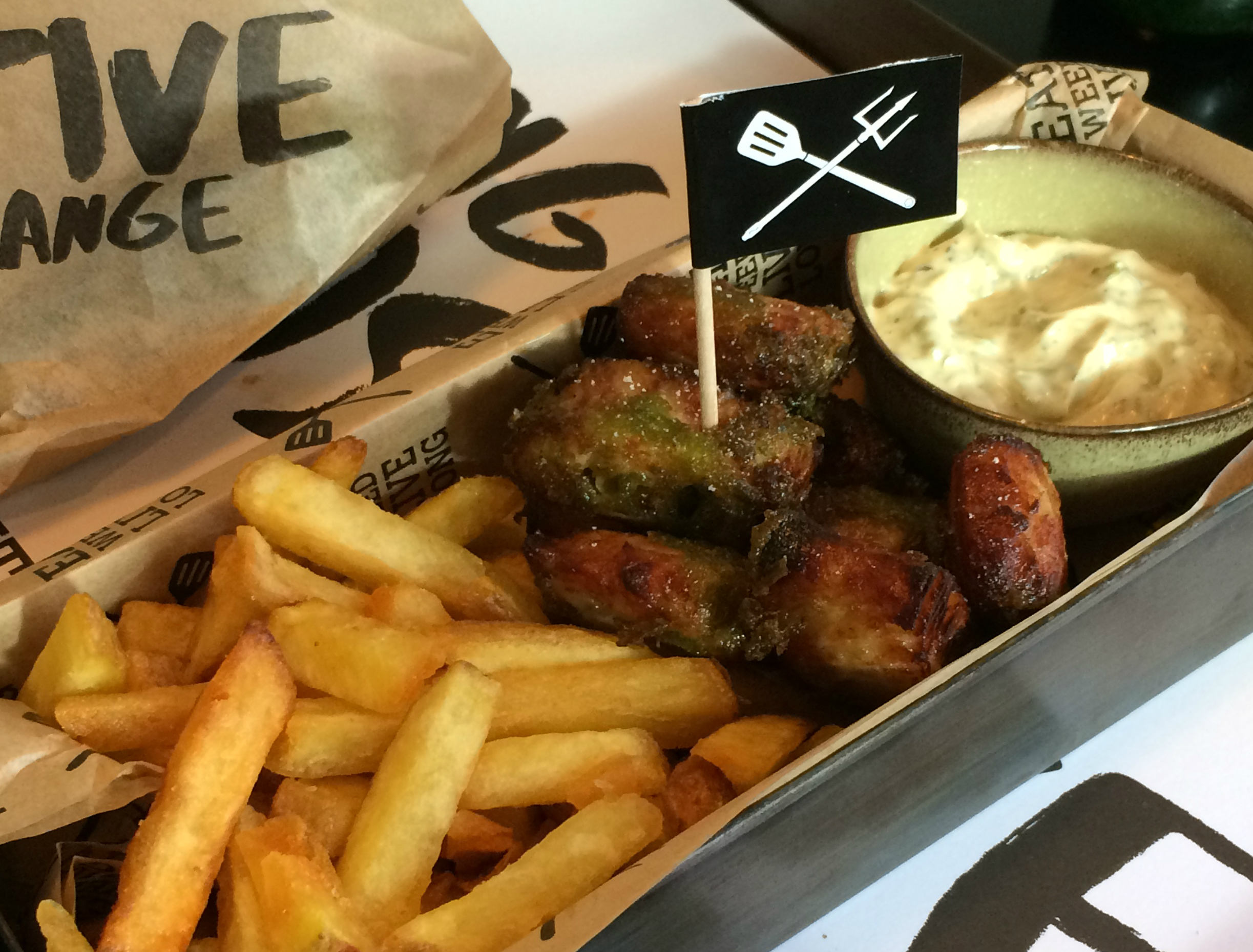
Speaking of weed, another culinary highlight of this trip was The Dutch Weed Burger, a fast-food restaurant fully in line with the spirit of its home city. But no, it’s not that kind of weed, not this time. Behind the provocative name is a culinary philosophy devoted to highlighting the virtues of another kind of plant—seaweed! From burgers and hot dogs to drinks and desserts, everything is made with a bit of added seaweed of one variety or another. We had a burger with kim chee plus the “wish ‘n’ chips”, a drink made with chlorella and a brownie (normal kind). It was all divine. I also loved their cute logo (a sort of partial Jolly Roger with a spatula and a trident) and the many clins d’œil to what people usually think of when you put the words “Dutch” and “weed” together—they refer to the restaurant as a burger “joint” for example, and their quarter-pounder is called the “extra high”. While waiting for our order, we paged through a book of plant-based, seaweed-added recipes called Groente uit zee that was written by one of the restaurant’s founders. It’s also available in English as Ocean Greens. I of course now want to get it, but luckily for my overcrowded bookshelves, it’s not so easy to obtain in France.
After the coffee shop imbroglio, we realized there was a better place to eat in the morning only a few blocks away. Vegabond is a little café that serves breakfast and lunch items, in addition to a range of hot drinks (with plant milks), and it also houses a vegan grocery store with a wide range of products including a locally made almond-based brie. I loved sitting there early in the morning before anyone else arrived, enjoying the ambiance of the sleepy street with a canal flowing lazily in front of it.

On our second-to-last day, I decided to make a side trip on my own to Delft (one hour from Amsterdam by train) to visit the Royal Delft factory and museum. I’d been wanting to see this town ever since reading Tracy Chevalier’s Girl with a Pearl Earring and seeing the film adaptation of it (although it was actually filmed somewhere in Luxembourg). And of course I also love all things porcelain, pottery and tile, and blue and white designs.

The town of Delft has (disappointingly) not remained frozen in time in the days of Vermeer, but it was still fun to amble around and look at the old buildings and narrow canals, which run right alongside the houses in some places. I was rewarded in my explorations with some “Delftware” street art!
The factory and museum showcased old plates commemorating Dutch royals as well as large murals made entirely of Delftware tiles and a 17th-century Dutch dining room set up for dinner with period tableware. You can enter a part of the factory to see where the pieces are fired, as well as a workshop where artisans painstakingly paint designs on prefired porcelain—interestingly, the glaze is black when applied and turns blue with the heat.
Your path out of the museum naturally takes you through the gift shop, which I personally found quite enjoyable although most everything was far out of my price range and too delicate for an apartment lacking a china hutch. The tea services, vases and so on are arranged in descending price brackets as you make your way through the shop, so in theory there is something for everyone. Among the more unique items was a €4,150 hand-painted Delftware version of Van Gogh’s Sunflowers, which in their defense is not actually that bad when you think about it. The work of painting it by hand to match the original must require a certain effort, and then you have a one-of-a-kind conversation piece bringing together two iconic Dutch things: Delftware and Van Gogh. Or maybe you could just sit at a Delft sidewalk café to draw the thing yourself in a sketchpad and tell people later how you did it on site. 😉 But anyway, those who don’t have the means for such a purchase can console themselves with a Delftware Christmas tree ornament (as I did) or rubber ducky (quite cute actually). A “Delftware” car was parked outside the gift shop, but didn’t seem to be for sale.
This little trip made for a fun afternoon, but it might not be worth the two-hour round trip if your time in Amsterdam is limited, since you can already find Delftware (or similar) and much more beautiful canals and houses in the capital.

That evening, back in Amsterdam, dinner was at the exclusive, by-reservation-only Japanese restaurant Men Impossible. It was my favorite dining experience of the trip. Guests are seated around a single communal table, a set-up that creates a truly intimate ambiance, and given a warm welcome by the gracious and friendly Atsushi, the proprietor and chef. After directing you to a seat, he hands you a laminated manga (click on the photo of it above to expand) that explains how to order and eat his ramen dishes which, after a starter, are the stars of the show. Atsushi makes all the ramen he serves by hand the same day—you can see why guests must reserve in advance! You choose between warm and cold noodles plus a soup that doubles as a sauce (I picked mushroom) and a flavoring that gets added toward the end (I had black garlic). The process for eating the dish was very precise, so the manga really came in handy—for example, you’re supposed to eat the soup and ramen separately at first (only dipping the noodles into the soup/sauce), and then pour the soup over the noodles later on. I don’t know if I managed to follow all the directions correctly or not, but this dish was one of the most delicious things I have ever eaten. The mushroom soup offered rich flavors bursting with umami and the noodles were very fresh with an amazing texture. And despite manning the kitchen and dining room all by himself, Atsushi was very attentive to his guests. I cannot recommend Men Impossible highly enough. If you’re ever in Amsterdam, find a way to go there (you can make a reservation online). And if you’re into space invaders, you’ll find one on the same street!
The last thing we visited before returning home was the Anne Frank House, a place I’d been curious about for years, ever since reading The Diary of a Young Girl as a teenager. We were actually very lucky to get in, as we hadn’t thought to reserve tickets before the trip started and on the day I checked for openings, absolutely every time slot during our stay was full except one (a group must have just canceled). I reserved spots for us as fast as I could! Plan far ahead if you want to visit this house during your stay.
The tour through the building and its achterhuis (“house behind”), as Anne called it, where her family hid, was a solemn and somber experience. I should point out that the hiding place actually no longer has any of its furnishings—Otto Frank, Anne’s father, requested that it not be furnished again and the photos above are of a recreation in another place. But you can stand in the same rooms where they lived and try to imagine their experiences. To recreate the conditions of the time, the windows are covered with blackout curtains and the interior kept fairly dark. Photos of the family and their helpers hang on the walls, but the audioguide that visitors are given as they enter the site has no recordings to go along with the spaces in which the family had lived, as if to promote reflection. We silently shuffled forward through the small, crowded spaces in step with the other visitors, each of us lost in our thoughts, imagining perhaps the day when the police came to bang on the door of the hiding place and take everyone away. There was a palpable sense of unease in the air and one woman began to cry.
A few vestiges from the days of their hiding remain. Some of the film stars from Anne’s collection are still pasted to her bedroom wall, and the pencil marks where Otto marked his daughters’ heights as they grew can be seen on the wallpaper behind a plastic panel.
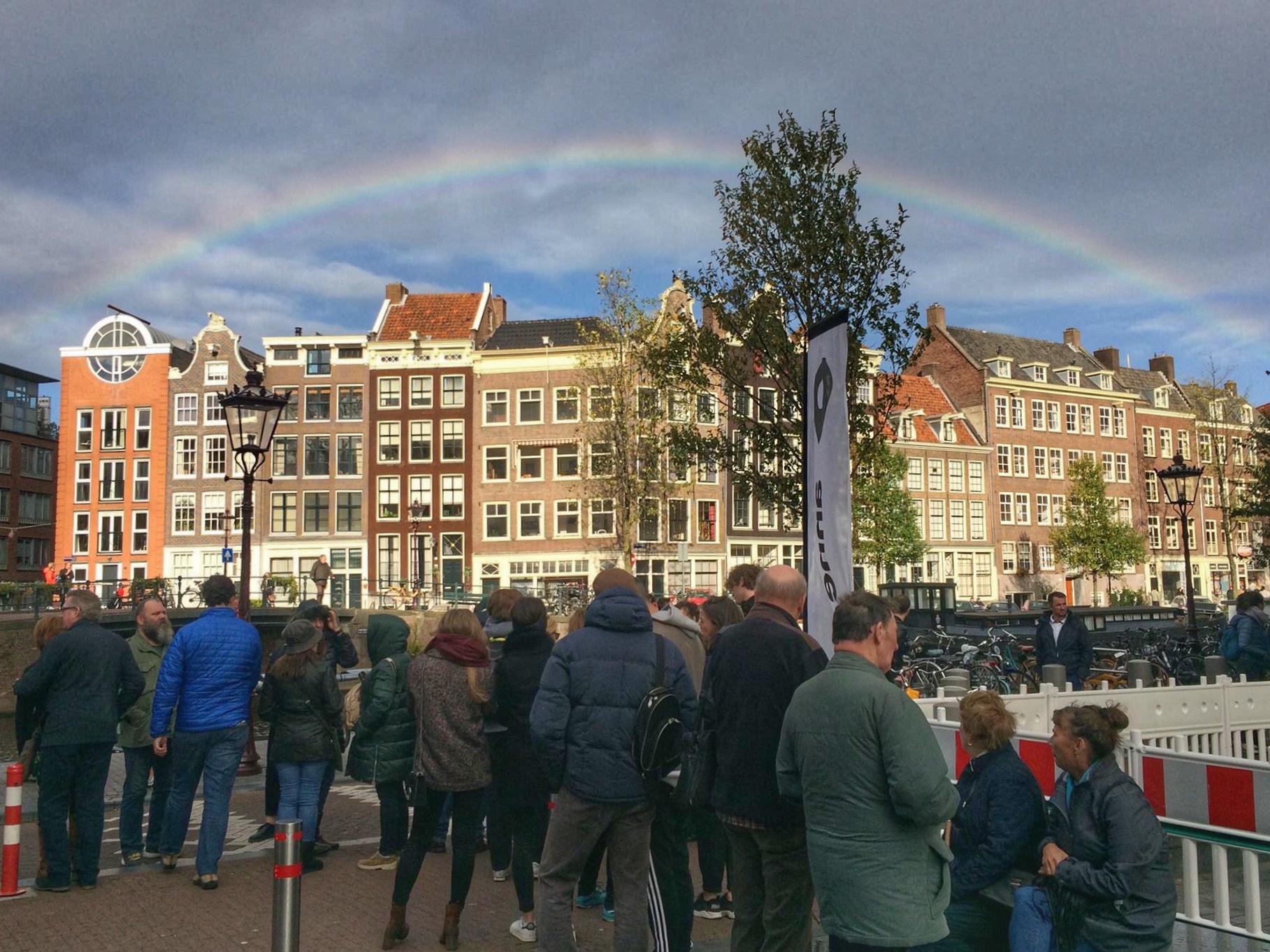
As we exited the building at the end of our visit, it had just been raining and an enormous rainbow stretched across the sky over the rooftops. As if Anne were saying hello.
My friends are used to hearing me say I want to move to whatever European city I’ve just been to, and to avoid testing their patience I won’t do that this time. But between you and me, this is a city I could probably get used to.
If you’re interested in learning more about Amsterdam but can’t visit just yet, you may want to check out Russell Shorto’s Amsterdam: A History of the World’s Most Liberal City (I’m about one-fourth through it and so far it’s been an entertaining read) or The Coffee Trader, a historical novel by David Liss set in 17th-century Amsterdam. I read it years ago and loved it.
Where will my travels take me to next? Stay tuned!
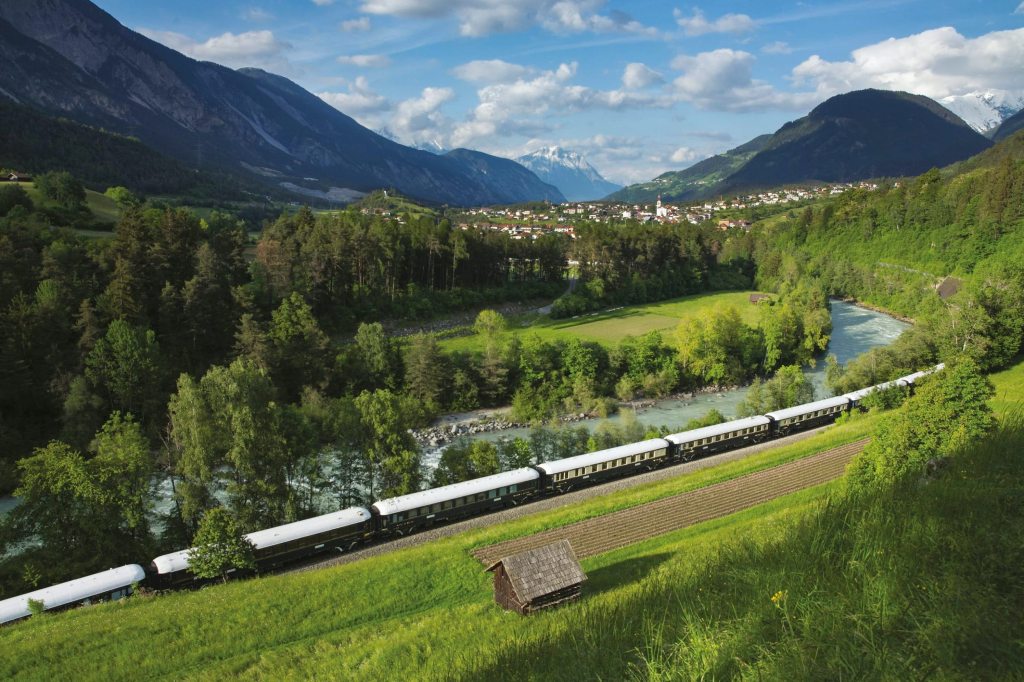


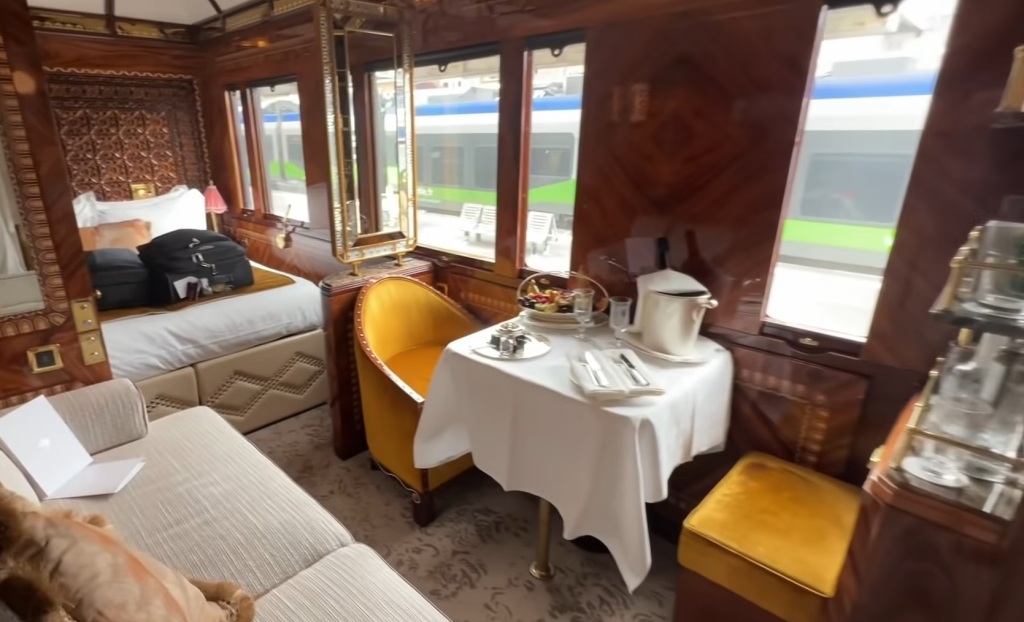
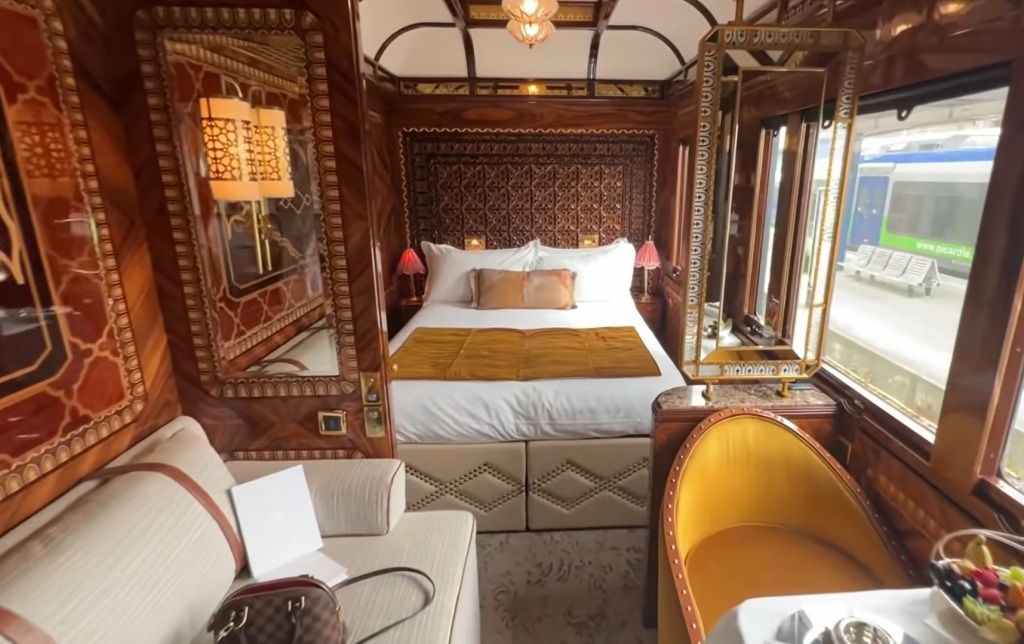
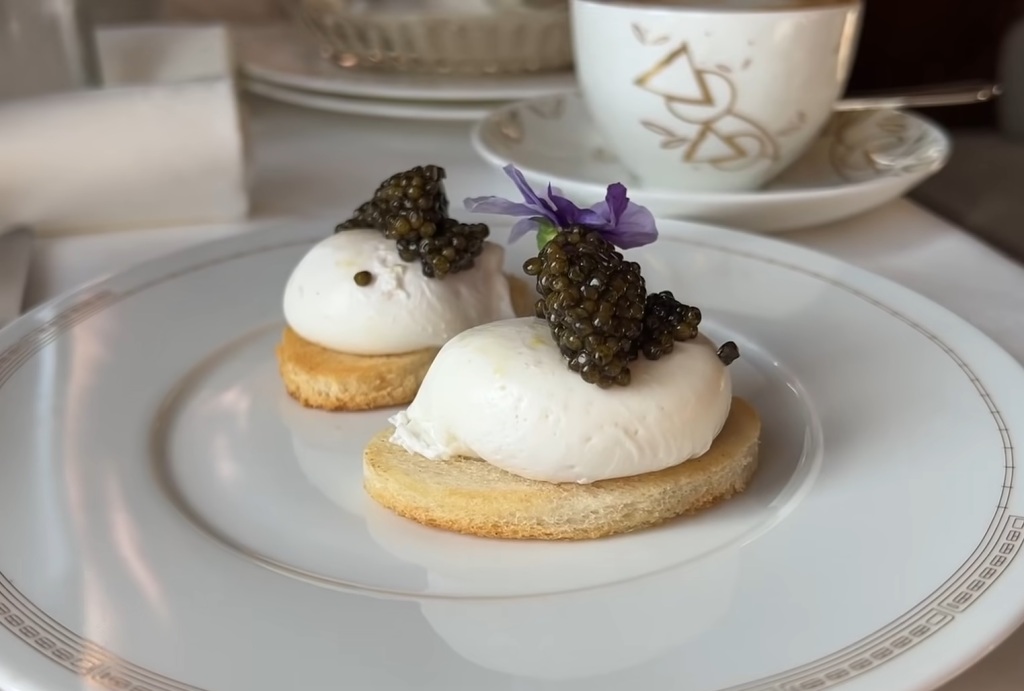

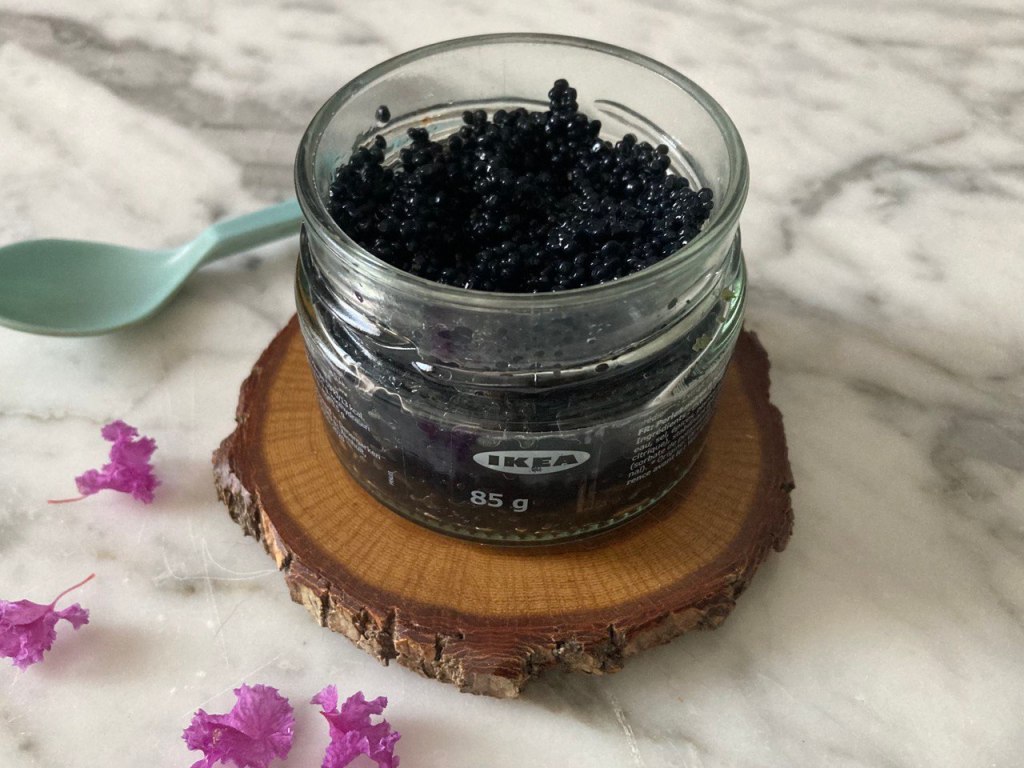
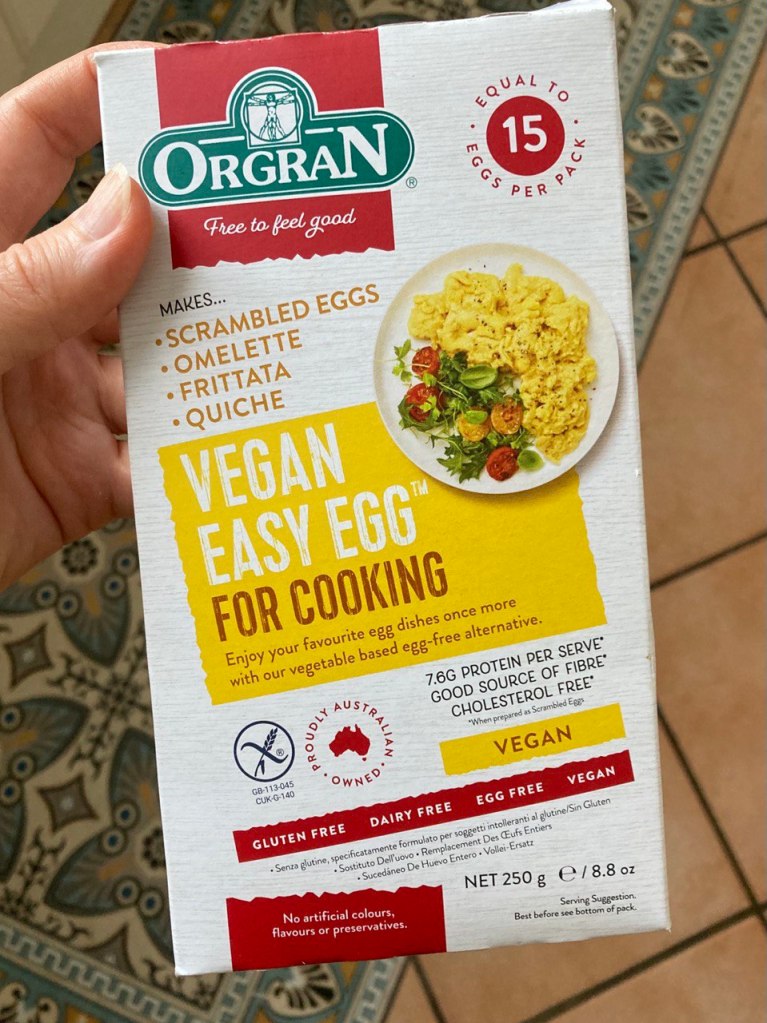
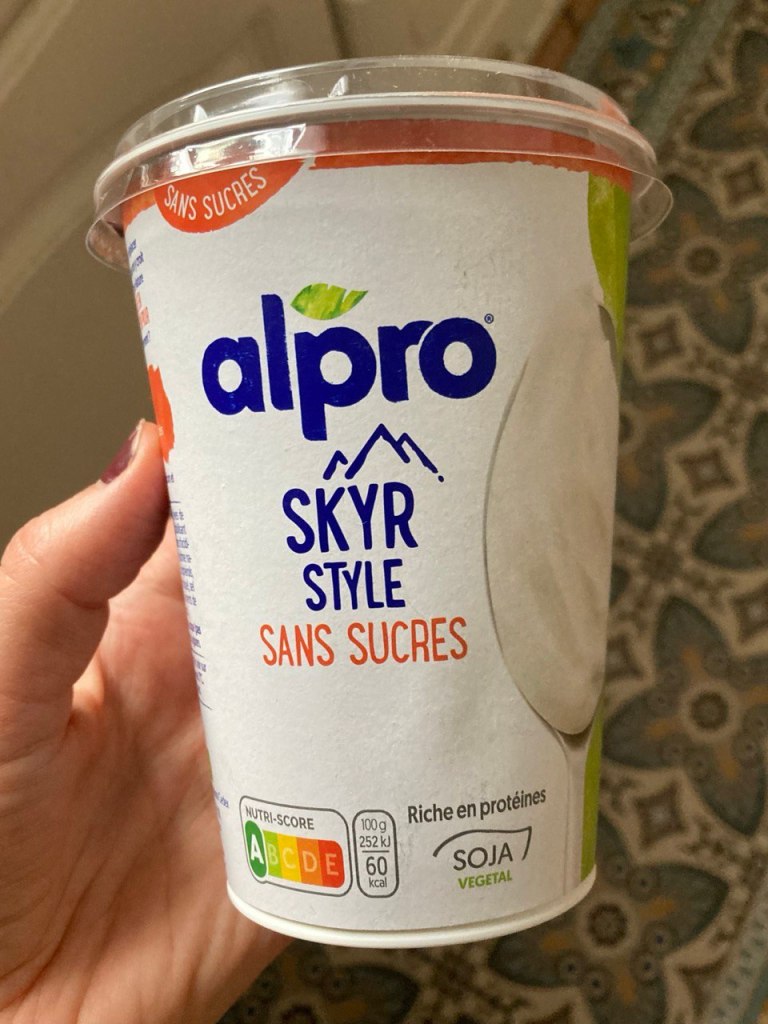
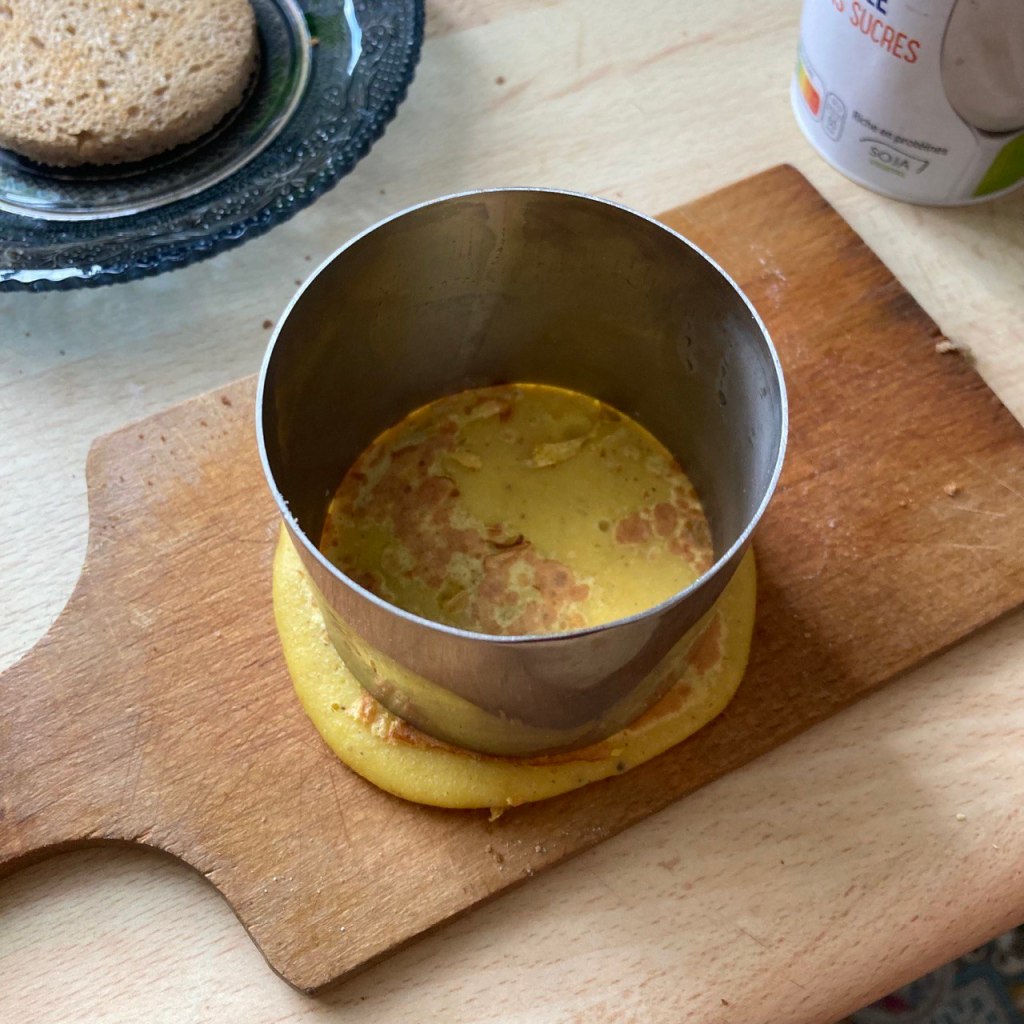
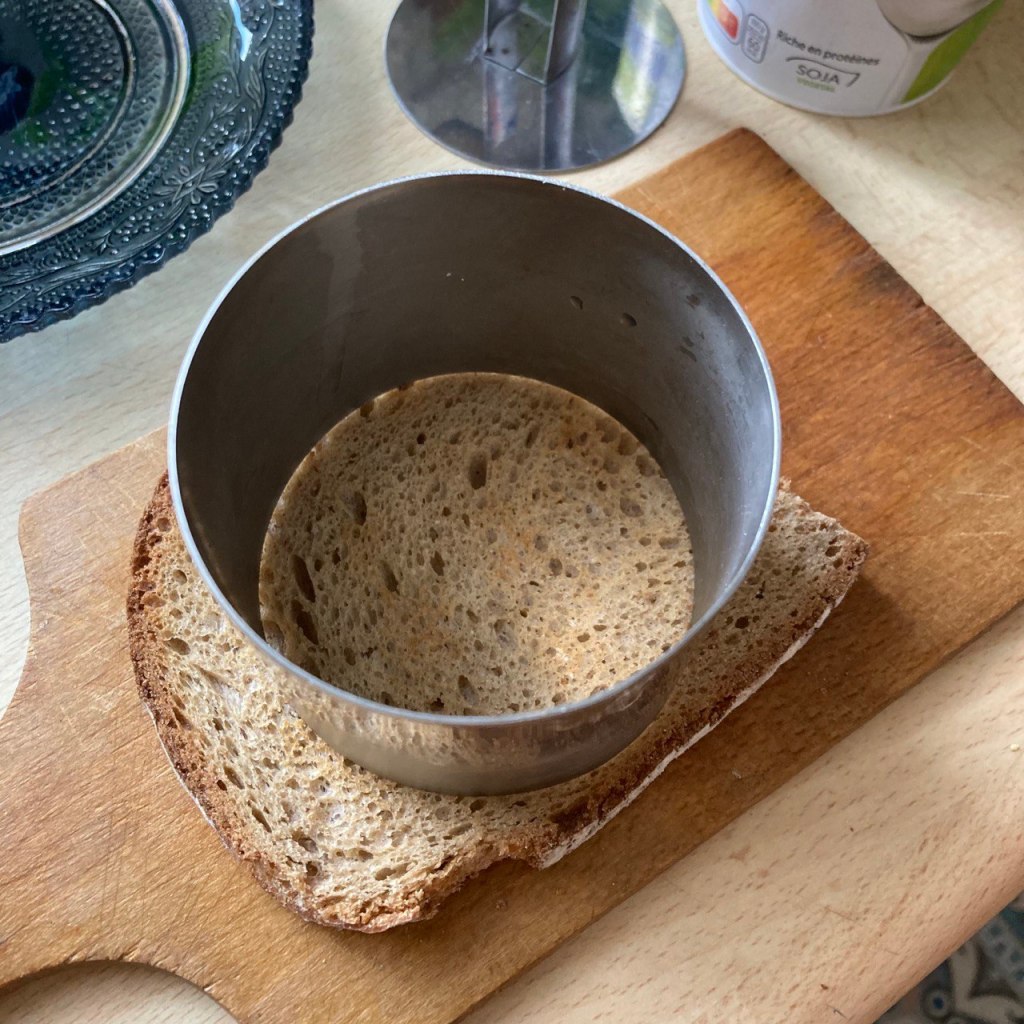
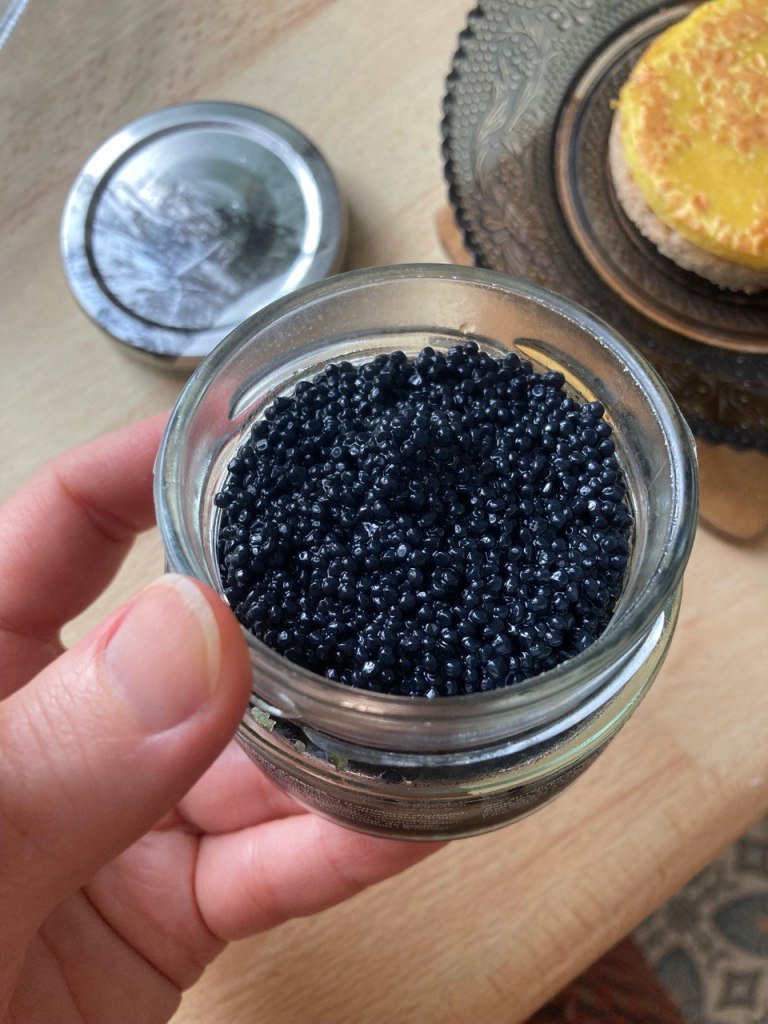
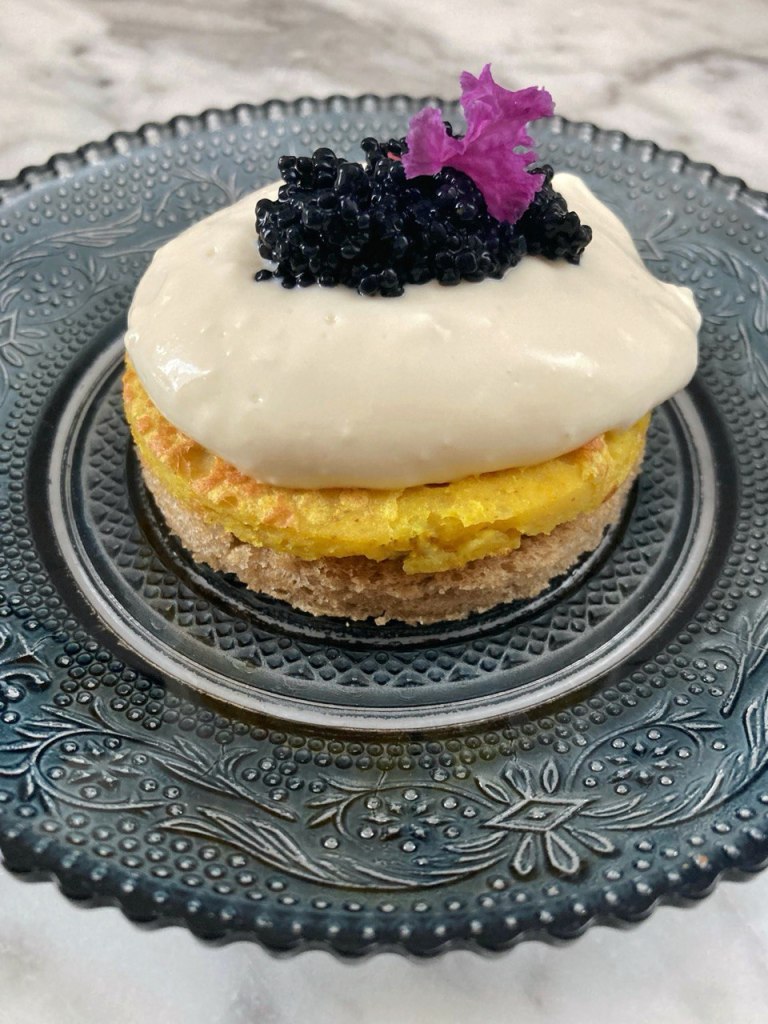
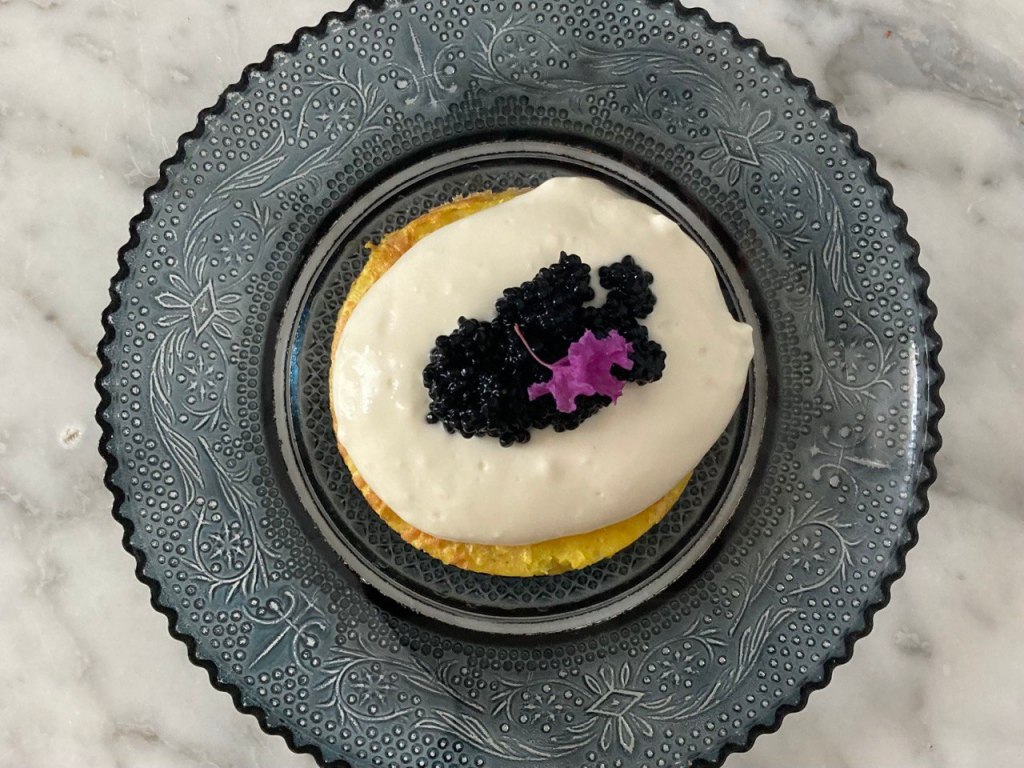
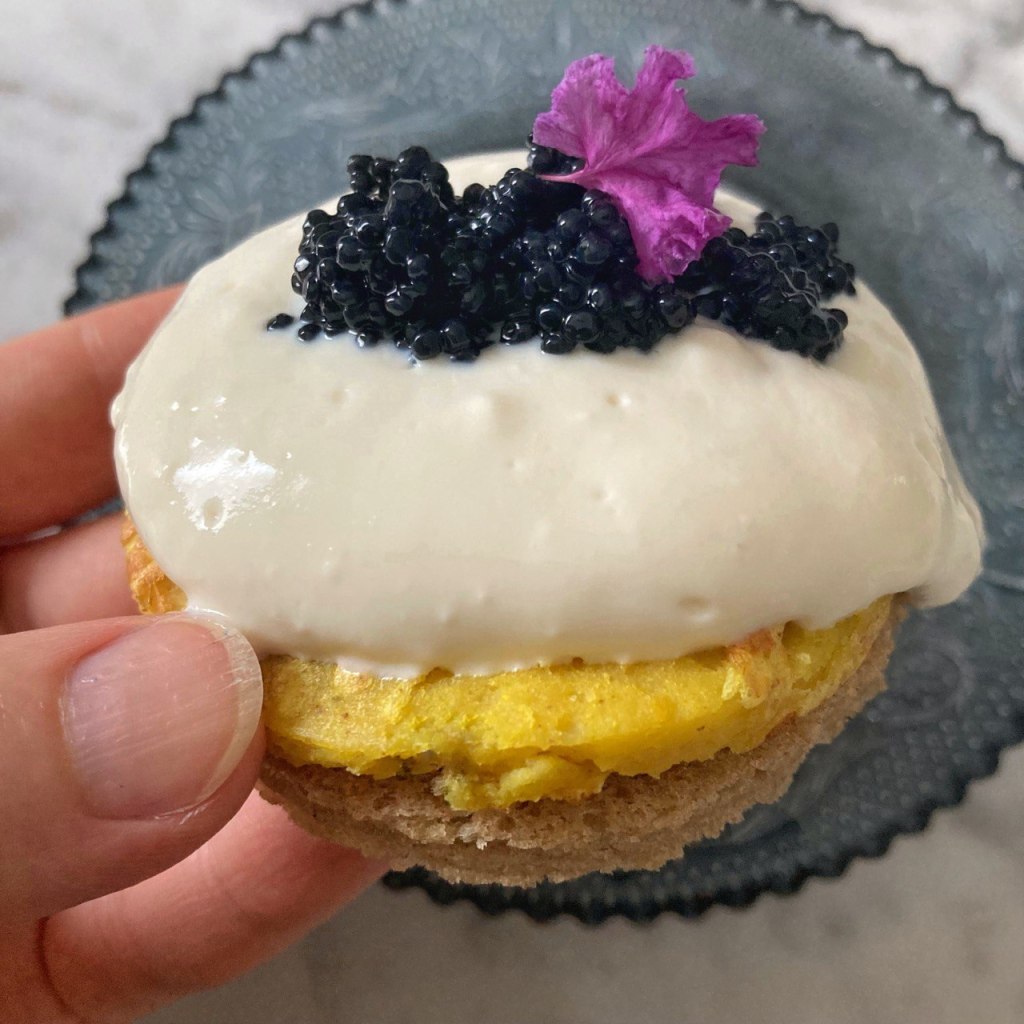
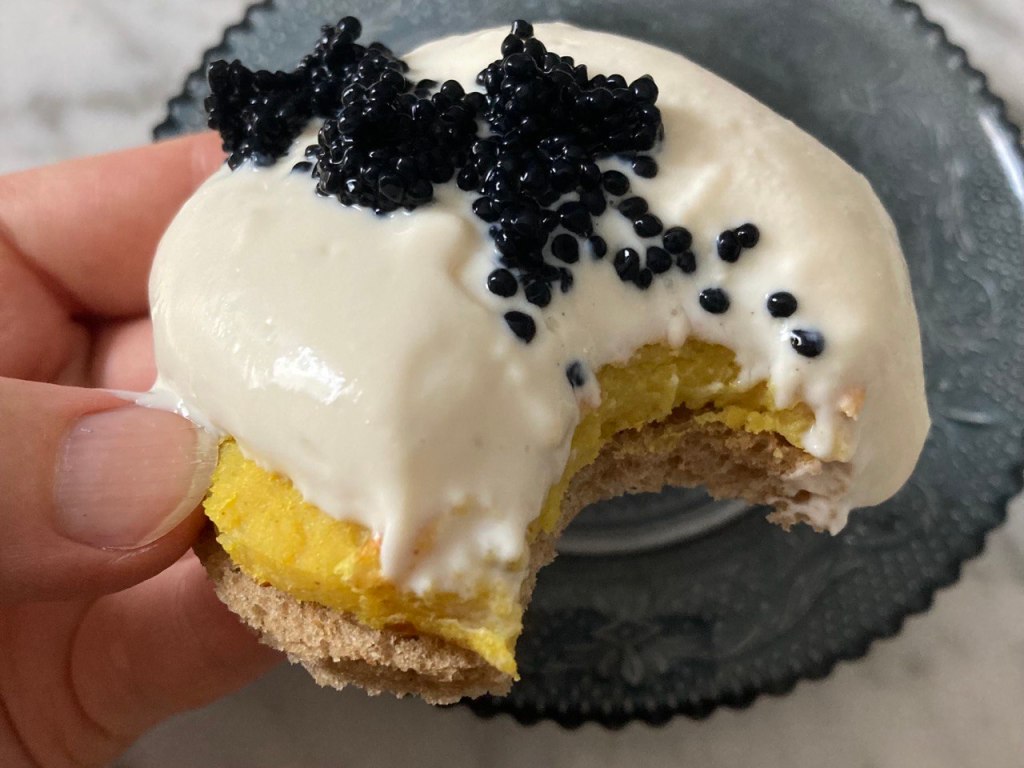

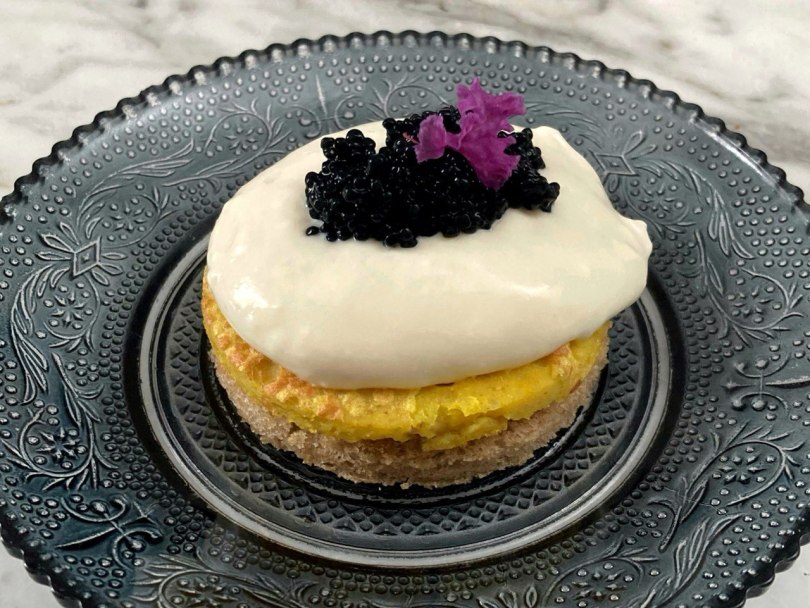

































 First, I had the good fortune to be hosted on the Lower East Side of Manhattan by an old friend and former roommate from my undergrad days. Being roommates again was a high point of my stay, reminiscing about the good old days and learning about this new-to-me city from someone who’d already explored it a fair amount.
First, I had the good fortune to be hosted on the Lower East Side of Manhattan by an old friend and former roommate from my undergrad days. Being roommates again was a high point of my stay, reminiscing about the good old days and learning about this new-to-me city from someone who’d already explored it a fair amount. But it turned out that while the reputation Paris has is (generally) well deserved, New York City’s isn’t. Throughout my entire stay, I consistently heard Excuse me, Sorry and Thank you, and on several occasions people spontaneously offered me help when I looked like I needed it. On my way into the city, loaded down with a heavy suitcase, I was looking at a flight of subway stairs in dismay when a passing woman volunteered that there was an escalator a bit further down the hall. Another time, I was sitting on a bench applying band-aids to my blistered heels when another passerby offered to supply me with more band-aids should I need them. And on the train to the airport on my last day, my fellow travelers (who could see from my luggage where I was going) helped me figure out what to do when the train service was temporarily halted, without my even having to ask.
But it turned out that while the reputation Paris has is (generally) well deserved, New York City’s isn’t. Throughout my entire stay, I consistently heard Excuse me, Sorry and Thank you, and on several occasions people spontaneously offered me help when I looked like I needed it. On my way into the city, loaded down with a heavy suitcase, I was looking at a flight of subway stairs in dismay when a passing woman volunteered that there was an escalator a bit further down the hall. Another time, I was sitting on a bench applying band-aids to my blistered heels when another passerby offered to supply me with more band-aids should I need them. And on the train to the airport on my last day, my fellow travelers (who could see from my luggage where I was going) helped me figure out what to do when the train service was temporarily halted, without my even having to ask. But on several occasions, locals actually did strike up a conversation. One afternoon, taking a break from a street art expedition in Brooklyn, I sat down in a café with a matcha latte and pulled Orlando out of my bag. The middle-aged gentleman working on a laptop at the table next to mine took his headphones off to remark on a coincidence: he was in the middle of writing an opera based on another of Virginia Woolf’s books! We spoke for a few minutes about the smallness of the world and the difficulties of adapting stream-of-consciousness literature to a musical form. When I asked when he expected to finish the piece, he chuckled and said sometime in the next decade. We each went back to our respective occupation and, making a mental note to pay more attention to operas, I wondered if he were somebody famous.
But on several occasions, locals actually did strike up a conversation. One afternoon, taking a break from a street art expedition in Brooklyn, I sat down in a café with a matcha latte and pulled Orlando out of my bag. The middle-aged gentleman working on a laptop at the table next to mine took his headphones off to remark on a coincidence: he was in the middle of writing an opera based on another of Virginia Woolf’s books! We spoke for a few minutes about the smallness of the world and the difficulties of adapting stream-of-consciousness literature to a musical form. When I asked when he expected to finish the piece, he chuckled and said sometime in the next decade. We each went back to our respective occupation and, making a mental note to pay more attention to operas, I wondered if he were somebody famous.


 The district has been home to
The district has been home to 
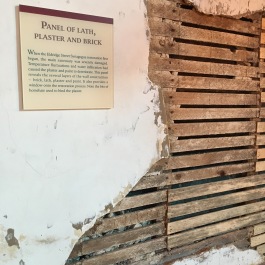















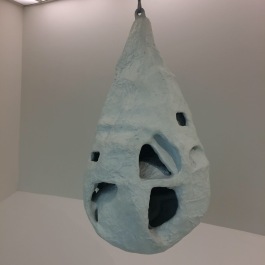














































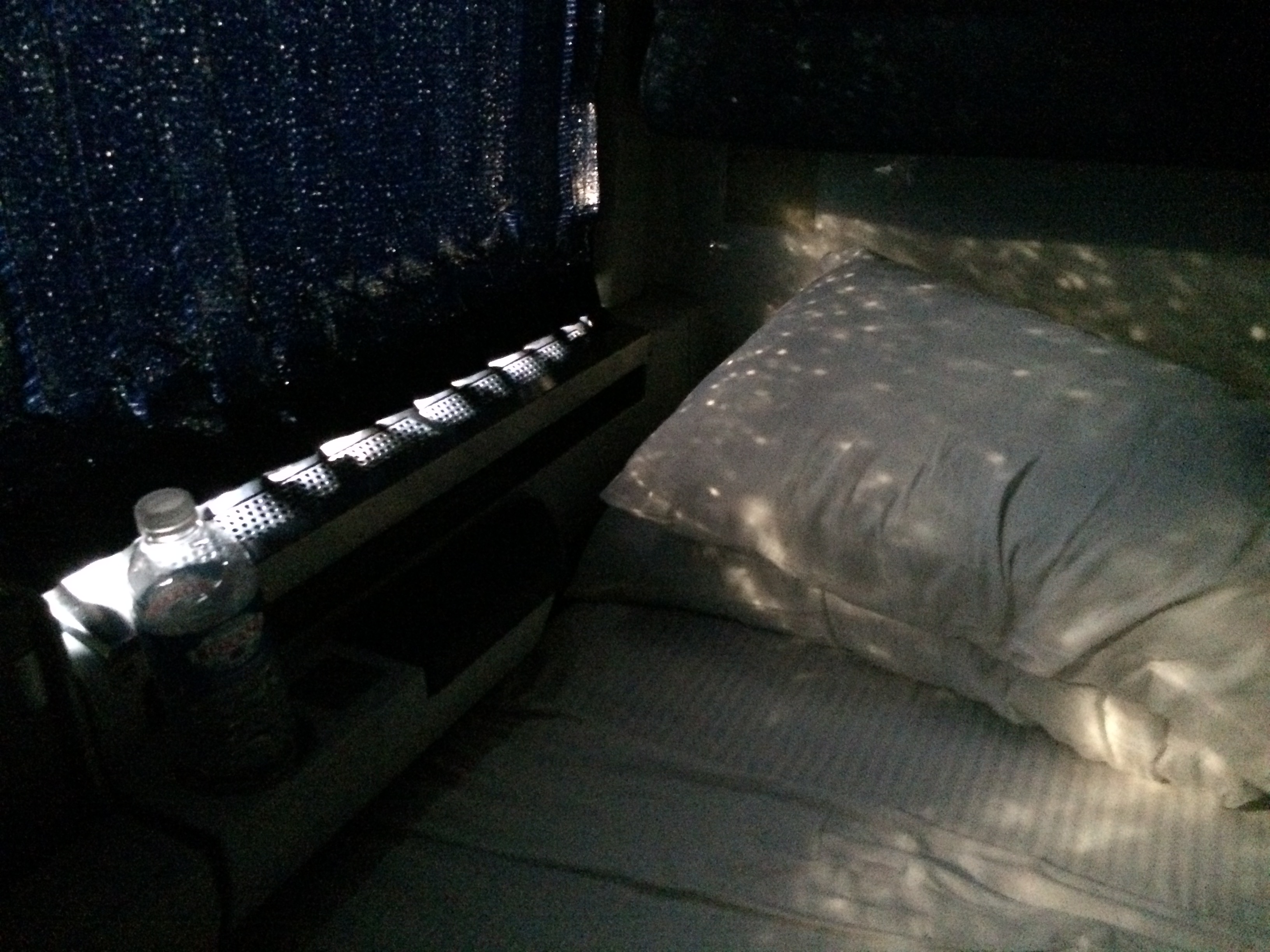



















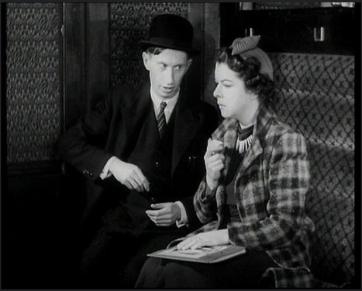


















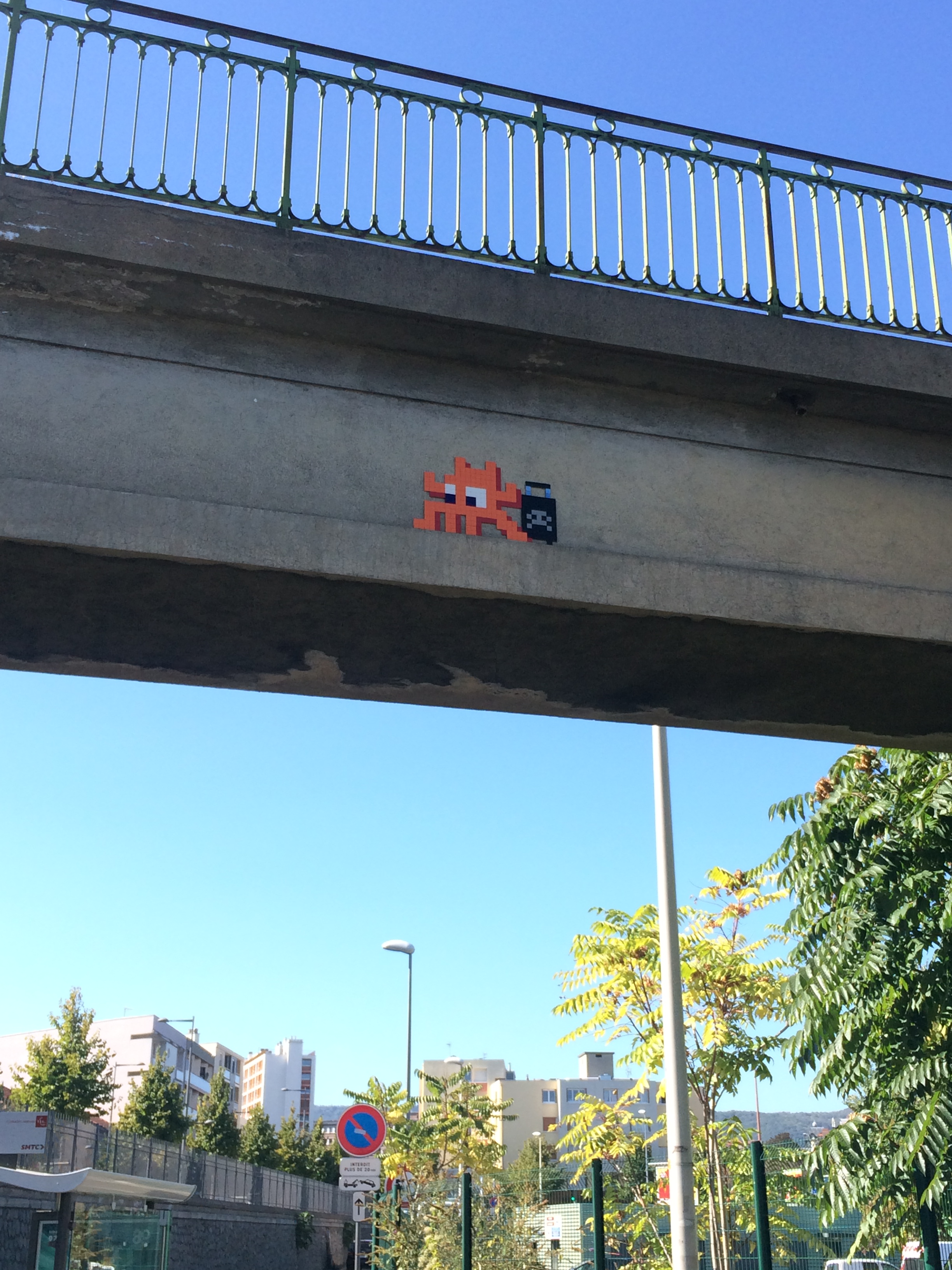












 At the store, I had some trouble finding the hummus (every vegan’s lifesaver) and began to worry there wouldn’t be any, but in the end emerged with enough provisions for an evening meal and breakfast the next morning.
At the store, I had some trouble finding the hummus (every vegan’s lifesaver) and began to worry there wouldn’t be any, but in the end emerged with enough provisions for an evening meal and breakfast the next morning.
